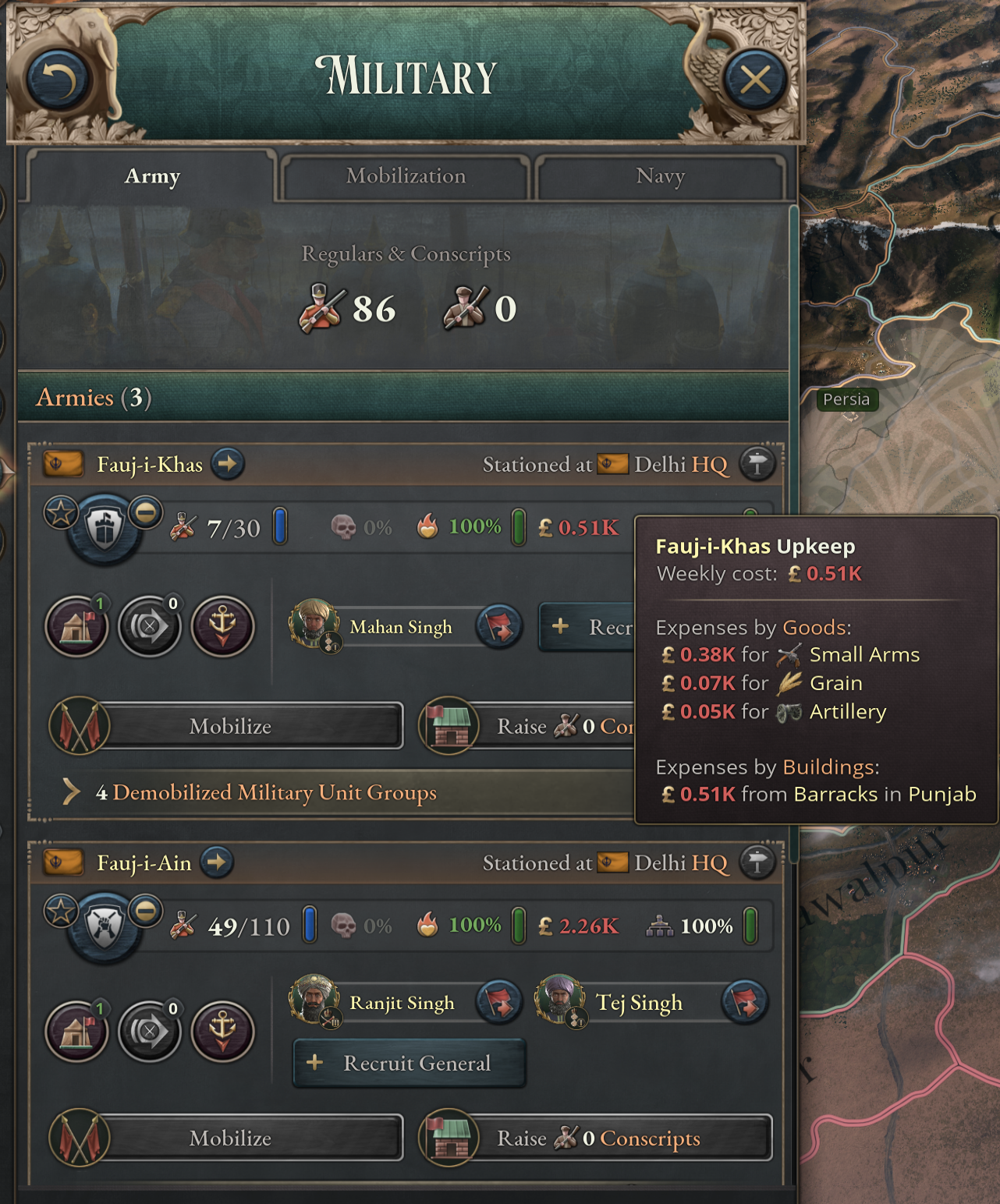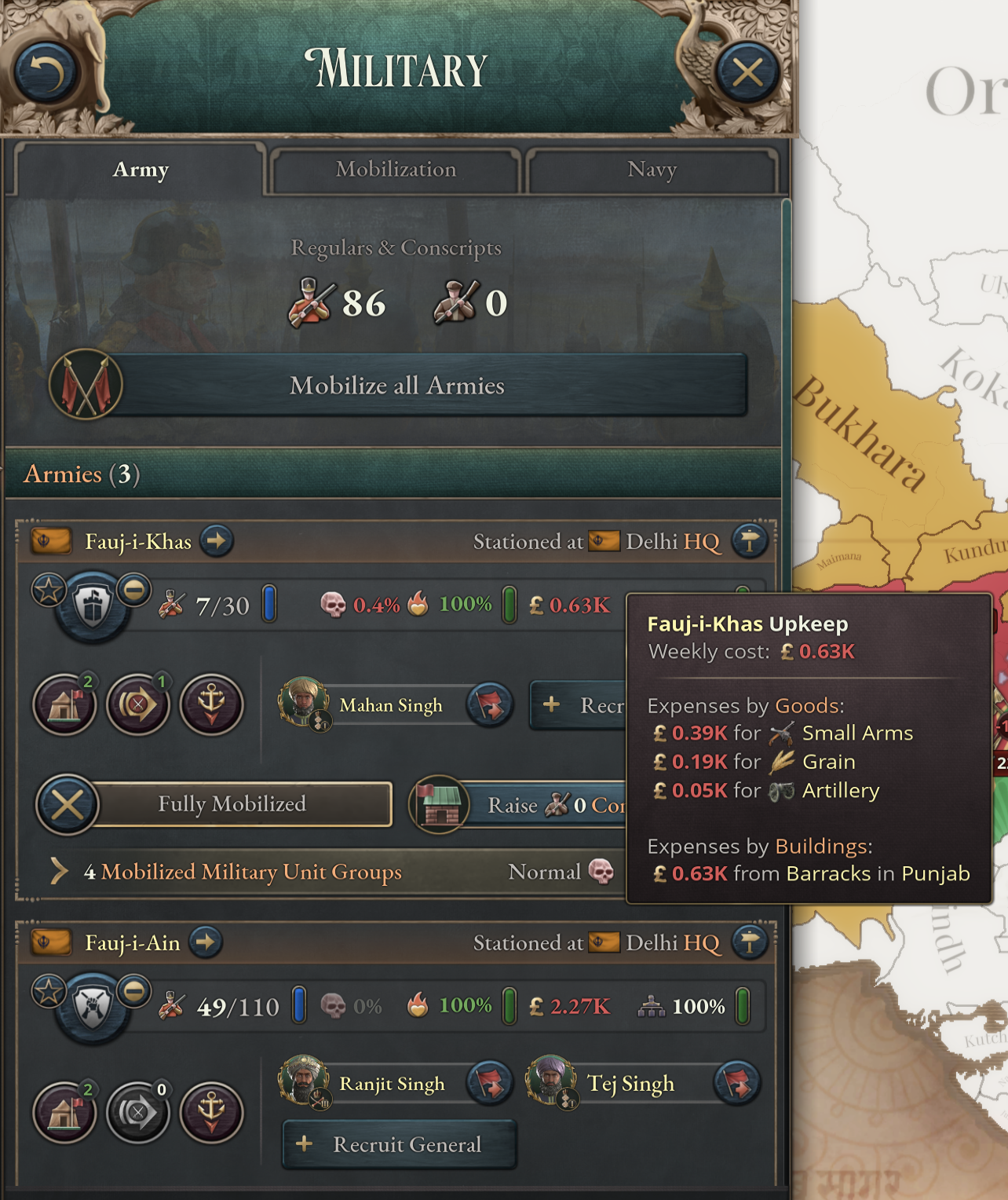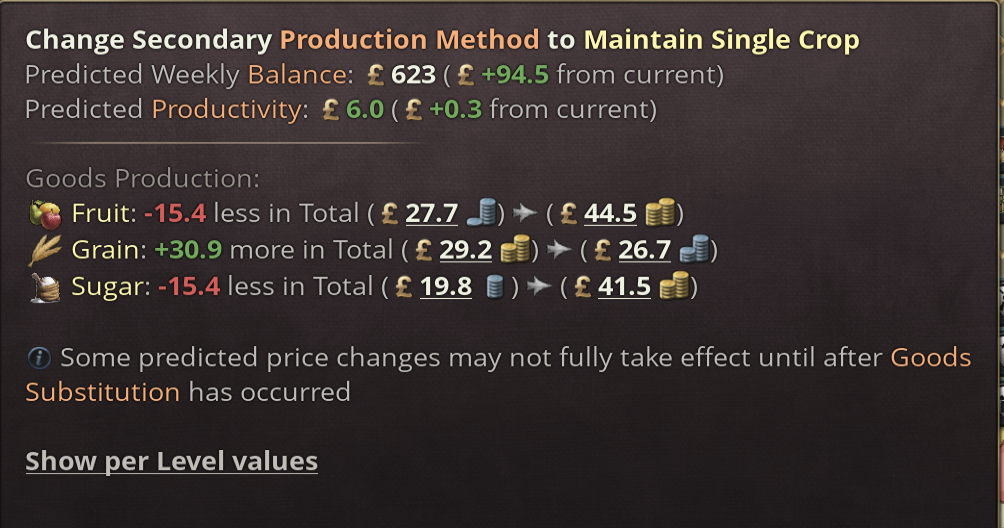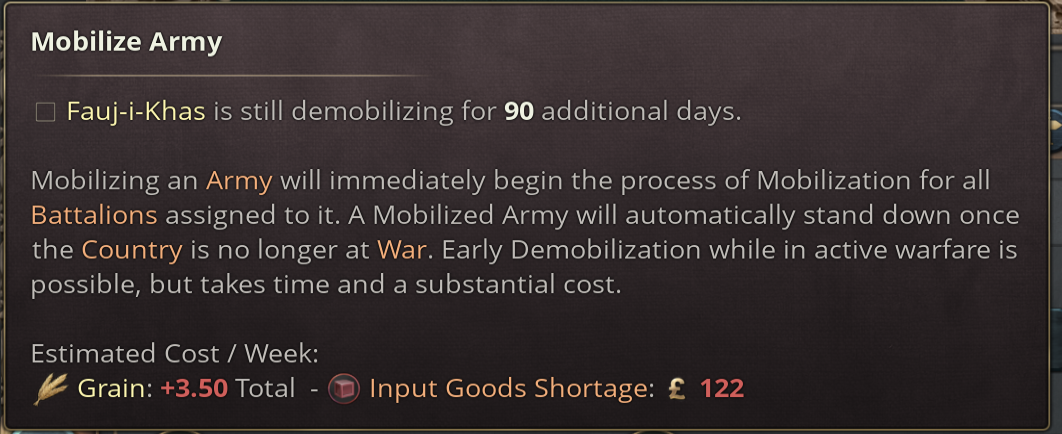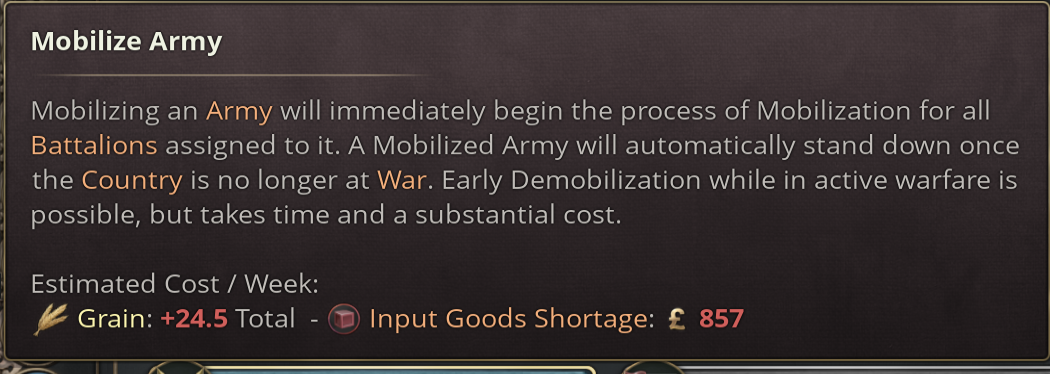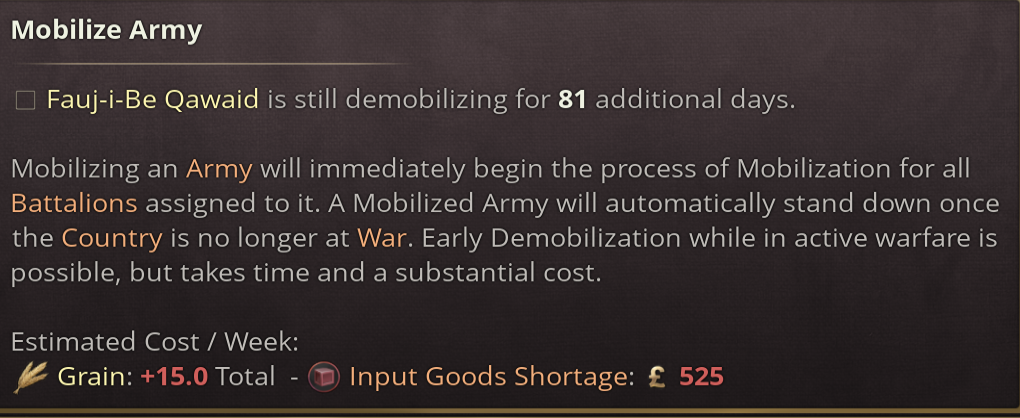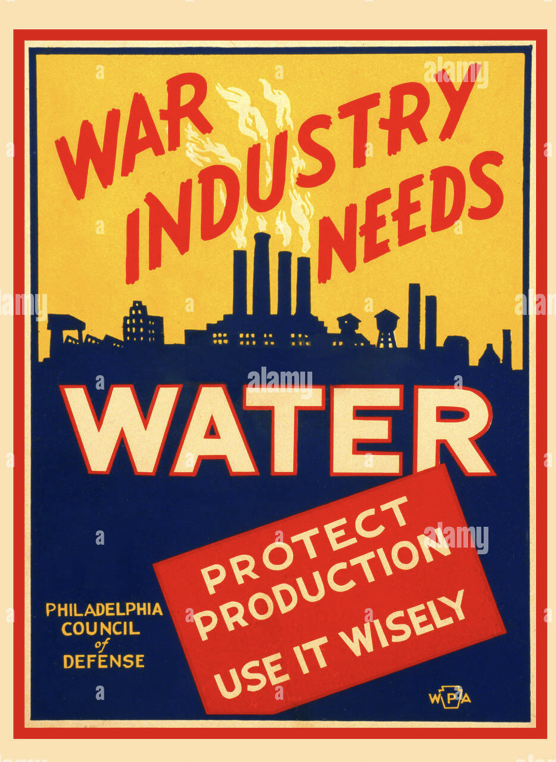.jpg)
Hello Victorians,
I’m Lino, Game Design Lead on Victoria 3 and I welcome you all to another Dev Diary and wish you a happy Thursday!
Today we’re looking at some Military changes that are arriving with the free 1.9 Update, coming to you on June 17, the same day our Mechanics Pack “Charters of Commerce” releases.
Before we begin: As always, any values, texts, designs, graphics etc. are work in progress and are subject to change!
So, obviously warfare has some issues, which we want to address. To repeat what we have stated before: The ambition for 1.9 is not to majorly expand on warfare, but rather to fix the most egregious persistent issues.
The main areas we had identified before embarking on this quest to improve warfare were:
- Too many front splits, which results in having to micro too much
- Shuffling of units along a front (usually when two fronts merge), leading to them not being defended while the units were travelling
- Formations teleporting home when they don’t have a valid route to get there
There are of course other issues, e.g. our user experience and interface could certainly be improved in some areas, supply should matter more etc., but these three are the cause of most of the warfare feedback posts we see on our forums, discord and other social platforms.
We have read through all your posts and decided on addressing the three points above (and more), based on your extensive feedback. First up is addressing frontlines and their splitting.
Frontline generation
Faced with the problem of having to micro after front-splitting, we sat down to talk about some requirements and possible options.We knew that it’s impossible to fully avoid front-splitting from happening in general. But that’s okay, that was never our goal. We cared about addressing the resulting issues.
One use-case we really wanted to improve was India. Well, fronts in India. Once the princely states decide they’ve had enough and declare war, we get an insane amount of frontlines generated all across the subcontinent.
This is due to the algorithm of how frontlines are created. It looks at continuous pieces of land that are connected to another continuous piece of land that is owned by your enemy and then spawns a frontline between the two basically.
Well, in the case of India, this will often lead to having 10-15 fronts because the princely states aren’t always located next to each other.
But what if we had a different algorithm? One that resulted in fewer fronts.
Let me introduce our patented “Why not jump?” front generation algorithm:
Instead of requiring fronts to be along a continuous piece of land, we are now telling it to jump for some distance if it would reach another front which it can merge with.
In the current version we have internally, we are looking at covering one state region of a gap. We will be experimenting with a version that instead looks at a specified distance in pixels to cover some of the weirder edge-cases where a state is either very small or very large.
We are quite happy with the results when you apply it to actual use-cases, for example the case of the Indian revolt that I mentioned earlier.
No longer will we have to endure 13 fronts

Now it’s just two instead


Now it’s just two instead

This is the biggest visible improvement we have done for this Warfare improvement cycle, but we have a lot more to cover. Next up is the shuffling of army positions.
Front camps
So, we’ve probably all seen armies march to the other end of a front they were assigned to, seemingly just because they felt like it.Well, in reality this is because armies are assigned to front camps, specific positions along a front to spread them out.
When two fronts merged or a front split, we would re-evaluate the front camps and the armies in them were assigned a new valid front camp. That could mean their new camp was on the other end of the front, meaning they’d pack up their things and start marching.
So we have taken a look at this algorithm as well and made some seemingly small changes which should result in a much smoother gameplay experience though.
We now make it so that as long as an army is positioned in a front camp, which is still valid after a front change, they stay there. The armies were spread out evenly before, so the same distribution should make sense after a split/merge too. This can still lead to armies starting to move, e.g. because it was their front camp that was invalidated (because it’s no longer part of the front for example), but that is a logical reason to move.
It’s hard to showcase this behaviour change in images, but internal test results have been positive about this and we hope you’ll feel the same. There’s much less unintentional shuffling of armies along a front which was the main point of this change.
Next up is another big frustration point.
Teleporting Armies
“Beam me up Scotty!” General Wolseley exclaimed when he found himself unable to attach to a front in India. And sure enough, two minutes later he was drinking tea with the Queen in Buckingham Palace.At least that is how it sometimes worked out in our game. Until now!
The issue of teleporting armies comes to be when there’s no valid front available for a formation to go to. This can happen for example when a formation is isolated by neutral territory or the front they were moving towards being pushed into unavailable space.
We’ve always had some fallbacks for missing spline connections for example, which allowed armies to simply march through terrain though there wasn’t really a path defined.
And teleportation was our fallback solution for the worse cases.
But now we are refining this particular one into more of an actual feature, which should make it possible for armies to not teleport home again. What we’re doing is to take a lesson from our other titles and implement an exiled army status.
Once an army finds itself in a situation where they would have previously beamed home, now they’ll enter exiled status and have to walk (or ship) home.
Exiled armies have a few special rules:
- They can march through neutral and enemy territory
- They are not able to attach themselves to a front, they need to regroup in a friendly HQ first. They will automatically target the nearest HQ (ignoring landlocked HQs unless it’s their home HQ) and go there.
- They suffer from attrition as if they were present at a front (more attrition in enemy territory than in neutral)
- Their organization value will drift towards 0 over time
Once an exiled army reaches their target HQ, they lose the exiled status and act like a regular formation again.
As this feature is still in development, I can’t show you too much yet, but here’s a teaser for the icon which will be used across all interface screens to visualize the exiled state


That’s the big three out of the way, but I have more to show today.
Since I just mentioned the army organization value, I think this would be a good time to briefly mention some changes on that front (ha!) before coming back to juicier additions.
Organization, Supply and Morale
Right now, organization is a value whose limit is determined by the commanders in the formation and used by your units. If there are sufficient commanders, it always is at the maximum value and if there suddenly isn’t (because an unfortunate accident happened), well then the organization will drop immediately to the new target value, leaving the army shattered.What we’re doing now instead is making organization a drifting value, meaning that when an important commander dies, the target is set to say 40 but it will take a while to go down from 100. Enough time for you to hire or promote a new general in their place.
Organization drifting from 100 towards 0 at a rate of 5 per day because the army is exiled (and has too many special units)
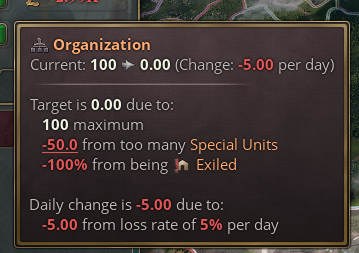
Negative effects from low organization also scale a bit differently now. When you have full organization, you suffer no consequences of course. If you go down to 0 you’ll suffer 100% of the penalties. Previously this was set to 25, but it’s working better with 0 and the drifting value.
Another small change we’re doing alongside this is that we’re adding a base command limit of 10. That means that small formations (max 10 units) do not require a commander to have full organization anymore.
Lean, mean killer machine

With regards to supply, we are making some small, but impactful changes too.
Previously supply impacted morale, instead it now affects it via organization. It does so by multiplying the organization target. So if the organization target of a formation is currently 100, but the formation’s supply is only at 50%, the organization target will be set to 50 instead.
This gives supply a lot more teeth than the previously rather harmless effects.
Here we can see the impact of a small supply penalty

Alright, so much for our little tour around these values.
Let’s get back to some meaty stuff again that I’m sure will excite many people.
Military Access
Military Access has been on our wishlist for a long time. It has proven tricky in our military system to define what exactly it actually means and how we can make it work in a way that makes sense for us.I don’t think I need to explain that much why having a military access system in the game is a good idea, but let’s just say it should allow a lot more countries to conduct war without a naval invasion.
The way this is set up is via a diplomatic pact that two countries establish. It’s one-sided, so for example Belgium could grant military access to Prussia without being granted the same. Additionally, having an alliance with another country will inherently also provide military access.
Note that the example of Prussia marching through Belgium is incidental and not a reference to any particular historical conflict which involved German soldiers marching through Belgium.
Small relevant spoiler for our next Dev Diary

What I should explain though is how Prussia can actually make use of the military access rights they just secured.
Let’s imagine we play as Prussia and find ourselves at war with France (silly example I know). Now we’d like to open a second front with them using a route through neutral Belgium’s territory into Champage to get to Paris.
Well, with the press of a few buttons, we’re able to do so.
Incorrectly found in the Navy tab currently. This will be adjusted before release.

Once you press the plan invasion button, you’ll see an interface you may know from Naval Invasions already, which shows all potential invasion targets, via the sea, but also via land.
Note the extra options for states Champagne and Lorraine which are accessible through the military access to Belgium.

When we select Champagne, we see the panel where you select your armies. Once selected, they’ll prepare for a while.
While the 2. Armee defends, the 1. Armee shall advance through Belgium!


These invasions via land will work almost like naval invasions, minus the boats. While preparations are ongoing, a new front is already spawned at the point of invasion so that the defender also has the time to react and send forces to defend. Once prepared, the Prussian attackers will be able to start advancing the new front.
Again, the invasion icon will be fixed before release

France on the other hand will only be able to defend this front and cannot push into Belgium. The conditions to see this front disappear are the same as for naval invasions, so after 3 failed attempts, the front disappears and the attackers return to their HQ.
But what if France wants to fight back and take the fight into Prussia? Well, they can also open a second front via Belgium. When any country uses their military access via a neutral country to invade another country, their enemies will also gain military access to the neutral country.
So keep that in mind when you go around securing these rights.
Next up, some interface improvements we’re doing.
UI Improvements
We have done a number of changes to the UI surrounding military and warfare which I’d like to present to you in this section.First up, we now use the more compact Mobilization window layout for formations by default. Previously the long list was very ineffective for how much space it was using and required a lot of scrolling.
Lots of small buttons, making better use of the space


We have updated the formation tooltip. It now shows which units are in said formation. Additionally we now expose Offense and Defense stats of units in fitting places.
Updated formation tooltip, including its units and offense/defense value in them
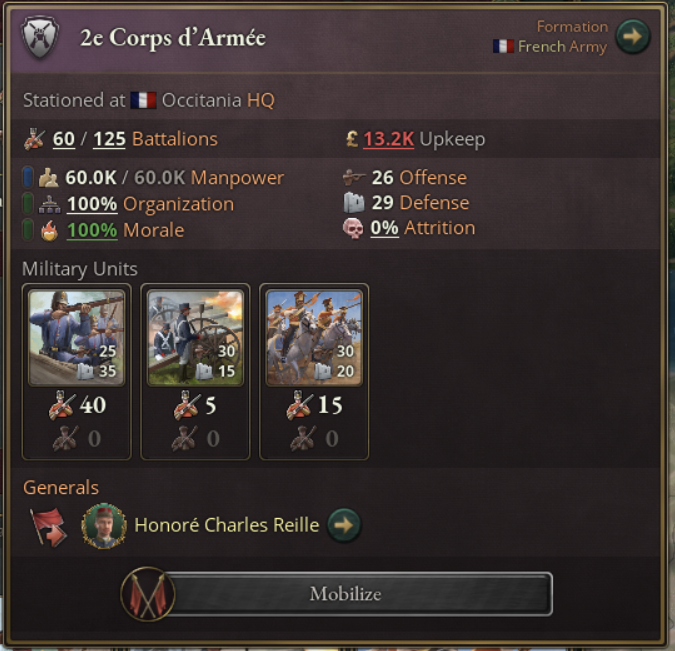
Default unit selection


Default unit selection

Also, the cost of war needed to be highlighted a bit more as it’s a pretty important number.
So in the Military tab, you’ll find a summary of your Military expenses now.
“4.56K for Iron bars?! Who approved this?”
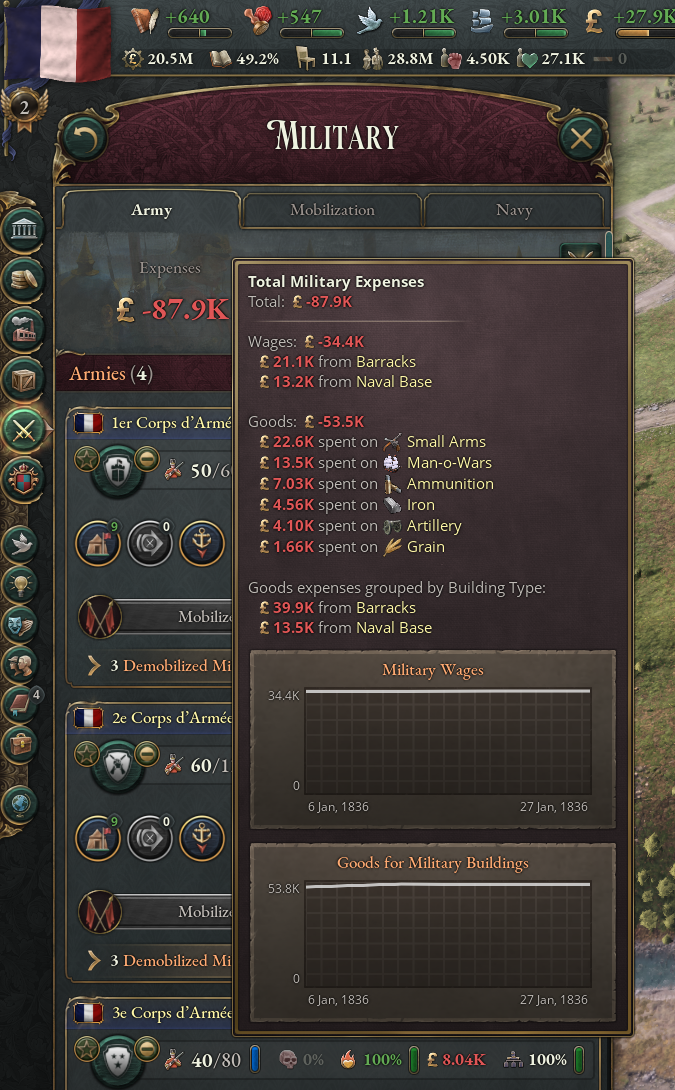

Another change we’re doing is to stack all allied/enemy formation markers that are on the same front. This drastically reduces the amount of clutter you see on screen when you’re at war. Your own formations are not affected by this. Hovering over the stack allows you to still see the individual groups that are summed up in it.
Before: Chaos!

After: So fresh, so clean

Showing what’s in a stack


After: So fresh, so clean

Showing what’s in a stack

Alright, I have one last feature outlook I want to mention today.
This feature is still very actively in development, but we want to let you know that we are currently working on implementing the possibility to edit mobilization options for your formations in bulk.
This will work by multi selecting any formations you want this to apply to and then have a central editing process which will apply the mobilization options to all selected formations.
Here’s a little outlook (all very much WIP), you can see 3 armies selected, the blue and yellow lines indicating that at least one army has selected the option

Closing thoughts
We are very happy with this set of improvements which ended up a bit bigger than originally expected and we look forward to hearing your feedback once you get your hands on it.I can’t stress enough that this is not marking the end of military improvements. We will continue addressing issues that aren’t up to par in free updates as we have always done.
We also would like to come back to the naval improvements we have previously teased, but these changes are much larger in scope so we can’t tell you exactly when they are coming at this point.
Also, before I leave you, here's an outlook of further Dev Diaries up until release of the 1.9 Update and Charters of Commerce, which releases June 17th:
- May 1st: Diplomatic Treaties
- May 15th: Company Charters
- May 29th: Prestige Goods
- June 5th: Other changes
- June 12th: Changelog

We will be back with Alex who will walk you through the very exciting Diplomatic Treaties feature in the next Dev Diary on the 1st of May.
Have a good day and see you in the comment section!



